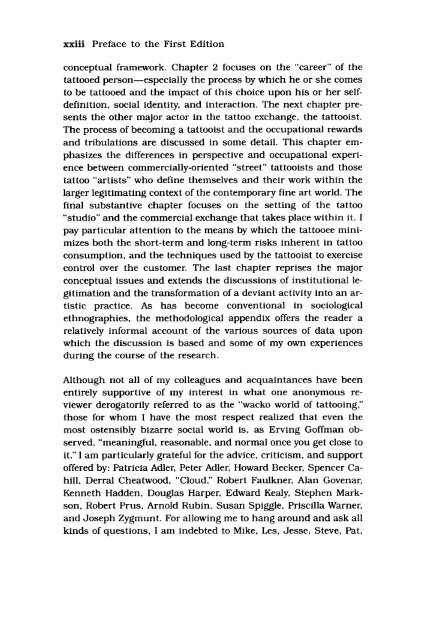Customizing the Body (PDF file) - Print My Tattoo
Customizing the Body (PDF file) - Print My Tattoo
Customizing the Body (PDF file) - Print My Tattoo
Create successful ePaper yourself
Turn your PDF publications into a flip-book with our unique Google optimized e-Paper software.
Preface to <strong>the</strong> First Edition<br />
xxiii Preface<br />
conceptual framework. Chapter 2 focuses on <strong>the</strong> "career" of <strong>the</strong><br />
tattooed person-especially <strong>the</strong> process by which he or she comes<br />
to be tattooed and <strong>the</strong> impact of this choice upon his or her selfdefinition.<br />
social identity. and interaction. The next chapter presents<br />
<strong>the</strong> o<strong>the</strong>r major actor in <strong>the</strong> tattoo exchange. <strong>the</strong> tattooist.<br />
The process of becoming a tattooist and <strong>the</strong> occupational rewards<br />
and tribulations are discussed in some detail. This chapter emphasizes<br />
<strong>the</strong> differences in perspective and occupational experience<br />
between commercially-oriented "street" tattooists and those<br />
tattoo "artists" who define <strong>the</strong>mselves and <strong>the</strong>ir work within <strong>the</strong><br />
larger legitimating context of <strong>the</strong> contemporary fine art world. The<br />
final substantive chapter focuses on <strong>the</strong> setting of <strong>the</strong> tattoo<br />
"studio" and <strong>the</strong> commercial exchange that takes place within it. I<br />
pay particular attention to <strong>the</strong> means by which <strong>the</strong> tattooee minimizes<br />
both <strong>the</strong> short-term and long-term risks inherent in tattoo<br />
consumption. and <strong>the</strong> techniques used by <strong>the</strong> tattooist to exercise<br />
control over <strong>the</strong> customer. The last chapter reprises <strong>the</strong> major<br />
conceptual issues and extends <strong>the</strong> discussions of institutional legitimation<br />
and <strong>the</strong> transformation of a deViant activity into an artistic<br />
practice. As has become conventional in SOCiological<br />
ethnographies, <strong>the</strong> methodological appendix offers <strong>the</strong> reader a<br />
relatively informal account of <strong>the</strong> various sources of data upon<br />
which <strong>the</strong> discussion is based and some of my own experiences<br />
during <strong>the</strong> course of <strong>the</strong> research.<br />
Although not all of my colleagues and acquaintances have been<br />
entirely supportive of my interest in what one anonymous reviewer<br />
derogatorily referred to as <strong>the</strong> "wacko world of tattooing:'<br />
those for whom I have <strong>the</strong> most respect realized that even <strong>the</strong><br />
most ostensibly bizarre ,social world is. as Erving Goffman observed.<br />
"meaningful. reasonable. and normal once you get close to<br />
it." I am particularly grateful for <strong>the</strong> adVice. criticism. and support<br />
offered by: Patricia Adler. Peter Adler. Howard Becker. Spencer Cahill.<br />
DerraJ Cheatwood. "Cloud." Robert Faulkner. Alan Govenar.<br />
Kenneth Hadden. Douglas Harper. Edward Kealy. Stephen Markson.<br />
Robert Prus. Arnold Rubin. Susan Spiggle. Priscilla Warner.<br />
and Joseph Zygmunt. For allOWing me to hang around and ask all<br />
kinds of questions. I am indebted to Mike. Les. Jesse. Steve. Pat.



